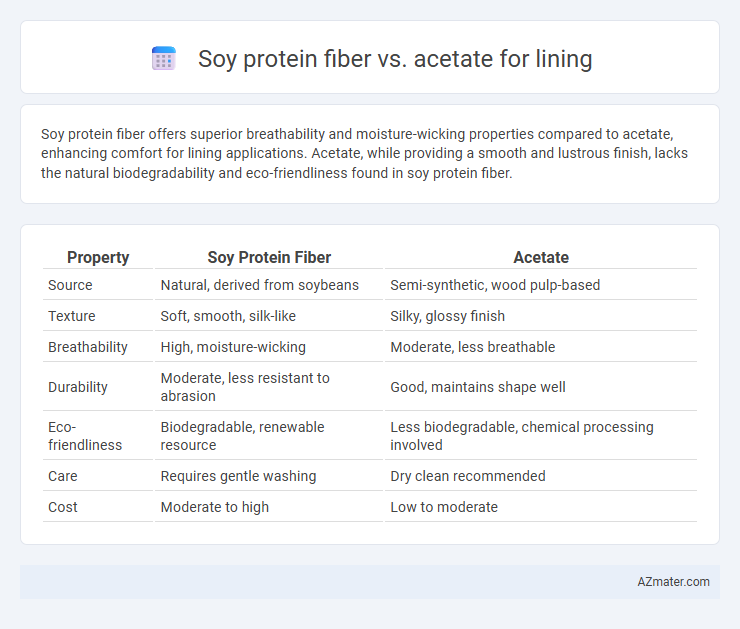Soy protein fiber offers superior breathability and moisture-wicking properties compared to acetate, enhancing comfort for lining applications. Acetate, while providing a smooth and lustrous finish, lacks the natural biodegradability and eco-friendliness found in soy protein fiber.
Table of Comparison
| Property | Soy Protein Fiber | Acetate |
|---|---|---|
| Source | Natural, derived from soybeans | Semi-synthetic, wood pulp-based |
| Texture | Soft, smooth, silk-like | Silky, glossy finish |
| Breathability | High, moisture-wicking | Moderate, less breathable |
| Durability | Moderate, less resistant to abrasion | Good, maintains shape well |
| Eco-friendliness | Biodegradable, renewable resource | Less biodegradable, chemical processing involved |
| Care | Requires gentle washing | Dry clean recommended |
| Cost | Moderate to high | Low to moderate |
Introduction to Lining Materials: Soy Protein Fiber vs Acetate
Soy protein fiber, derived from natural soybeans, offers sustainable, biodegradable qualities and a soft, breathable texture ideal for eco-friendly lining applications. Acetate, a synthetic cellulose-based fiber, provides smoothness, sheen, and resistance to humidity, making it a popular choice for luxurious linings in garments and upholstery. Comparing these materials highlights soy protein fiber's environmental benefits versus acetate's durability and aesthetic appeal in lining fabrics.
Origin and Production: Understanding Soy Protein Fiber
Soy protein fiber, derived from soybeans through a process of protein extraction and fiber spinning, originates from renewable plant sources, making it an eco-friendly alternative to synthetic fibers. Acetate fiber, produced from cellulose extracted from wood pulp and treated with acetic acid, represents a semi-synthetic fiber originating from natural but chemically modified materials. Understanding the distinct origins--soy protein fiber being purely plant-based protein and acetate being regenerated cellulose--highlights their differing production methods and environmental impacts in lining applications.
What Is Acetate? Manufacturing and Composition
Acetate is a synthetic fiber derived from cellulose acetate, primarily produced by chemically modifying wood pulp or cotton linters through acetylation. It is commonly used for linings due to its smooth texture, lightweight properties, and resistance to moisture and mildew. The manufacturing process involves dissolving cellulose in acetic anhydride and acetic acid, then extruding it into fibers that offer a luxurious feel and elegant drape in garment linings.
Comfort and Breathability Comparison
Soy protein fiber exhibits superior moisture-wicking properties and natural breathability compared to acetate, enhancing comfort in garment linings. Its biodegradable composition allows better air circulation, reducing heat retention and skin irritation often associated with acetate. While acetate provides a smooth, silky feel, soy protein fiber's ability to regulate temperature and maintain dryness makes it a more comfortable choice for prolonged wear.
Moisture Management and Thermoregulation
Soy protein fiber offers superior moisture management compared to acetate due to its natural hydrophilic properties, effectively wicking away sweat to keep the skin dry. Its inherent thermoregulation capabilities help maintain a balanced body temperature by promoting breathability and moisture absorption. Acetate, while smooth and lustrous, lacks the same level of moisture absorption and breathability, making soy protein fiber a more efficient choice for lining in active or warm environments.
Durability and Longevity Analysis
Soy protein fiber exhibits superior durability compared to acetate in lining applications due to its enhanced resistance to abrasion and stretching over time. The protein-based structure of soy fiber contributes to improved longevity by maintaining structural integrity after repeated wear and washing cycles. Acetate linings tend to degrade faster under friction and moisture, leading to a shorter lifespan in garments.
Sustainability and Environmental Impact
Soy protein fiber offers a biodegradable and renewable alternative to acetate for lining materials, reducing reliance on petroleum-based products and minimizing environmental pollution. Its production generates lower greenhouse gas emissions and consumes less water compared to acetate manufacturing, which involves chemical processes that can release harmful byproducts. Choosing soy protein fiber supports circular economy principles by enhancing biodegradability and lowering overall ecological footprint in textile applications.
Dyeability and Aesthetic Qualities
Soy protein fiber exhibits excellent dyeability due to its natural protein structure that readily absorbs and retains vibrant colors, resulting in rich and diverse hues for linings. Its smooth, silky texture provides a luxurious aesthetic quality, offering a comfortable hand and subtle sheen that enhances garment interior appeal. Acetate linings, while also highly dyeable with vibrant, glossy finishes, tend to have a more synthetic appearance and less moisture-wicking ability compared to soy protein fiber, impacting overall comfort and aesthetic perception.
Cost Considerations and Market Availability
Soy protein fiber offers a sustainable and biodegradable alternative to acetate for lining, often priced competitively due to increasing production scale, but its market availability remains limited compared to acetate's extensive global distribution. Acetate, derived from cellulose, benefits from well-established manufacturing and a widespread supply chain, resulting in consistent pricing and broad accessibility across apparel industries. Cost considerations favor acetate in large-scale applications, while soy protein fiber appeals to niche markets prioritizing eco-friendly materials despite its higher and fluctuating production costs.
Best Applications: Choosing Between Soy Protein Fiber and Acetate for Linings
Soy protein fiber linings offer superior moisture-wicking properties and biodegradability, making them ideal for sustainable fashion and activewear linings. Acetate linings excel in providing a smooth, lustrous finish with excellent drape, preferred in formalwear and luxury garments. Selecting between these fibers depends on performance needs: soy protein fiber suits eco-conscious, breathable applications, while acetate is favored for its aesthetic appeal and silky touch.

Infographic: Soy protein fiber vs Acetate for Lining
 azmater.com
azmater.com